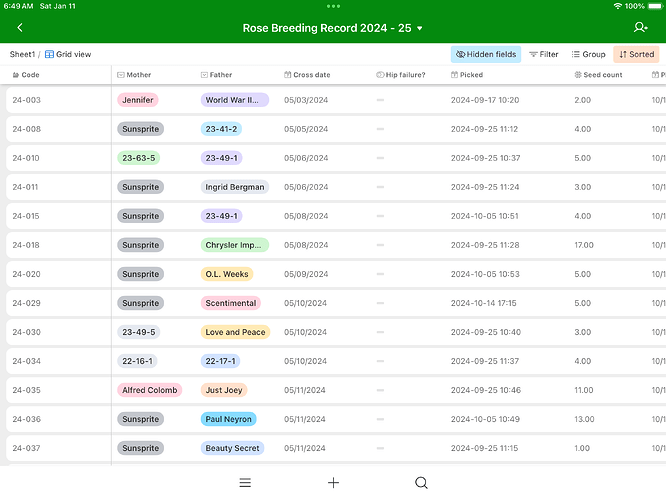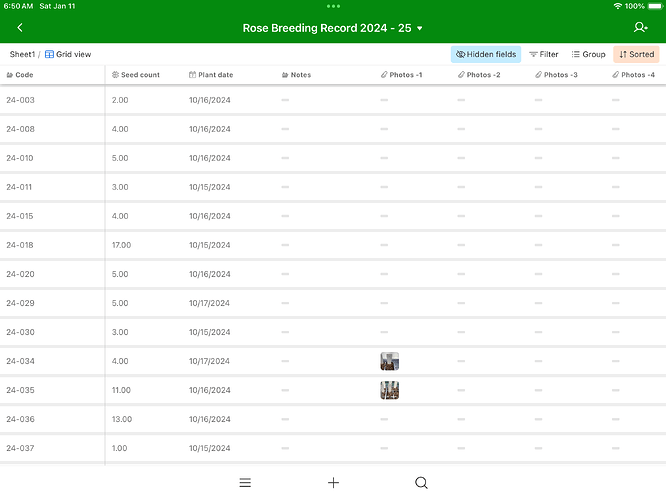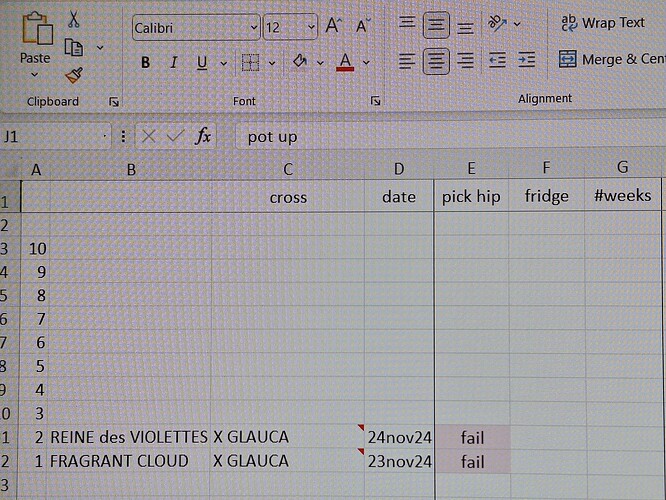I am puzzling over how to lay out a hybridising spreadheet. Having dabbled with a trial propagation of a few open pollinated hips and creating a spreadsheet as part of that trial I can already see that for the handful of roses I want to play hybridysing with recordkeeping is potentially monumental.
What fields would you deem essential?
How many fields would you could consider a comfortable maximum?
Do you use ‘notes’ much or prefer additional fields?
Would you use a new ‘sheet’ for each year or each species?
Any other tips, please.
I’m sure there’s a myriad of approaches to this, but this works well for me:
I happen to like the Airtable app (mostly because it’s free), and screenshots of the structure are below. As way of explanation, in the spring I will start a new spreadsheet, and as I conduct crosses, they will each be assigned a year and sequential number (e.g. 24-001 was my first cross in spring 2024). The mother, father and date are also recorded at this time. I Sharpie that unique number on a strip of masking tape, and wrap it below the hip. We have an “Apple household”, so I can take my phone along to the garden, and record crosses as I go along, and then later the information is automatically transferred to my iPad and Mac.
There is next a column labeled “Hip Failure”, and if I notice during the season that the cross didn’t take, I simply take out my phone, check that column, and it sorts those to the bottom of the list, so that I’m not wasting time looking for them in the fall.
When I do harvest the hips, there is a column then for that date, and the number of seeds. I record the planting date (all seeds into a single Petri dish for each cross with the identifier written on the lid). They are then stratified.
As germinations later begin, the resulting seedlings are pricked from their dishes to starter tray cells and assigned a sequential suffix (e.g. 24-001-1 would be the first germination of the 24-001 cross). I create a small 4” stake tag with this identifier and place it in the cell with the seedling. This identifier remains with the seedling throughout its life.
One nice feature of Airtable, is that I can take all the pictures I want of each seedling as it grows up within the app, and you’ll notice that there are columns for storing those pictures. Those pictures are also automatically dated, so I can review pictures and get some idea of comparative vigor. I find this is a helpful adjunct to my notes, especially if I am considering culling something in the spring, and haven’t seen it since last summer.
There is a single note field that frankly gets a little crowded if you happen to get 12 germinations from a single hip, but you could easily create a note field for each seedling if you wanted.
Hope this is helpful.
Helpful? Definitely! And pasting images is a revelation! Lee, I greatly appreciate the time you have taken to type, at length, your process. Now I can see where to winnow my table to something more manageable - what needs to go in and what can be amalgamated or dispensed with.
Attached, for your amusement, is where I got to on my own…
I can easily see the utility of spreadsheets for this even though I haven’t employed them for breeding myself. That is probably because my crossing work is usually more organic/exploratory/small-batch and less systematic/big-batch in nature, and I have too strong a compulsion to write in long thoughts and paragraphs. However, I use spreadsheets in other areas of my life, so here is what I would recommend:
I would keep all of my data in a single master sheet. If you feel the need later on, you could always then copy portions out into separate sheets. That way, all of the source data will remain formatted the same way, and will contain the same overall field/column structure. If you do start out with multiple sheets, try to at least use the same field/column structure anyway. That’s important if you want to make direct comparisons involving data from multiple sheets later on. Being able to sort and compare everything quickly and easily is a solid reason to keep it all together in one sheet from the start; it will also help you to avoid accidental naming/numbering duplication if you are assigning unique identifiers.
I like using notes for personal use, but you can only view them while hovering over a cell, and they are a pain to extract later if you want to view them all alongside the other data or print them. So, when starting from scratch, it might be better to avoid them and simply include additional note columns instead.
Essential fields are very personal and need to be tailored to your own breeding practices, objectives and observations. The must-have fields should become pretty obvious to you as you begin compiling some data. I’m not really trying to track things like germination percentages or numbers of floating vs sinking seeds, but others are. For some, pollination and harvest dates might be very important, especially if they live where growing seasons are short. There’s no natural need to cap the number of fields/columns, especially not if you freeze the top row and the most essential left-hand columns so that they are visible whenever scrolling to the right or downward. However, everyone’s brain is wired differently, so go easy until you learn what you can handle.
One last bit of advice for anyone who doesn’t use spreadsheets very often: never, ever leave a column’s first row/header blank, because as soon as you go to sort your data, anything on the other side of the first column lacking a header will fail to sort at the same time, leaving you with potentially irreparable data misalignment.
Stefan
Choc full of great and thorough advice for beginners, again, thank you Sefan. (All cells in the header row now have an entry!) Generally, for repeat tables I would copy sheet and delete cell data thus retaining the field/column structure - what I uploaded was
- the trial propagation of OP hips’ trial spreadsheet and
- early/draft specific hybridising spreadsheet,
they were never meant to intermingle. However I am glad I asked the questions before progressing any further.
What you express regarding tailoring for hybridising ‘objectives and observaions’ is very pertinent and something I have yet to manifest in concrete terms - what to record to help achieve a blended orange, sweetly fragrant, thornless, climber with very full, flatish blooms. (I have already detected a need for a PM / BS category… )
)



